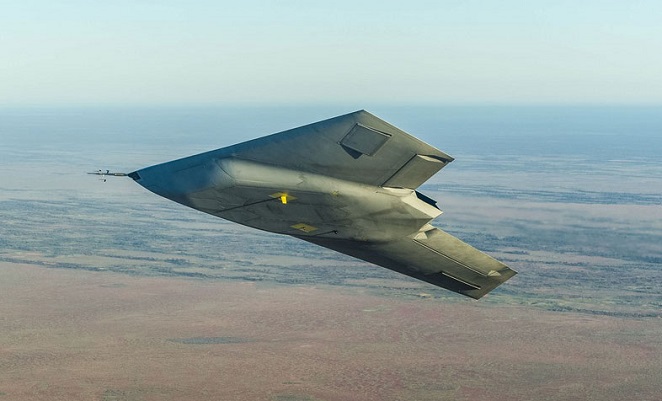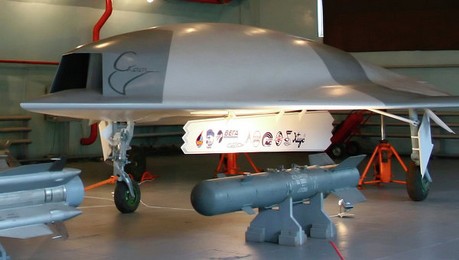
In early February the British Ministry of Defense pranked the aviation world with the surprise announcement that its Taranis jet-powered drone prototype flew for the first time … six months ago. The ministry and manufacturer BAE Systems managed to keep the whole thing a secret.
Taranis is only the latest in a growing stable of high-performance robot warplane prototypes meant, ultimately, to be armed with missiles and bombs.
Most of them share certain characteristics. They’re jet-propelled and shaped more or less like bats, lending them high subsonic speed and a certain amount of radar stealth, but possibly less endurance than older, propeller-driven robot models—just 12 hours instead of 24.
They’re all between 30 and 66 feet from wingtip to wingtip. And if they don’t already have internal weapons bays, they’ll surely get them, as that’s a requirement for avoiding radar detection.
Here they are, one by one—the world’s killer drones. The likely shape of future air warfare.

Taranis
Great Britain’s answer to America’s growing fleet of killer drones, Taranis is moving through development very, very slowly. BAE Systems based in London cut the first steel for the sole prototype back in 2007 and began ground tests with the 30-foot-wingspan ’bot in 2010.
It took three years and $300 million to finally launch the thing. By then the Americans—not to mention the Chinese and French—had similar drones much farther along in testing.
But BAE Systems still considers Taranis’ first flight, which reportedly took place in Australia, a major triumph. “The findings from the aircraft’s flight prove that the U.K. has developed a significant lead in understanding unmanned aircraft which could strike with precision over a long range whilst remaining undetected,” the company boasted.
The Ministry of Defense hasn’t decided yet whether to develop a fully combat-capable drone based on Taranis. The Royal Air Force is flat broke, after all, and can’t even afford to hold on to all of its brand-new Typhoon manned fighters, to say nothing of introducing an exotic new drone warplane. London may even combine its drone efforts with Paris.
But if Taranis does proceed, expect the follow-on version to be much bigger—probably with a wingspan of 50 or 60 feet, which seems to be a sweet spot for drone developers needing to balance speed, range, agility and payload.

Pegasus
The U.S. Navy’s X-47B Pegasus is the unchallenged queen of killer drones. The two X-47s, built by Virginia-based Northrop Grumman as part of a nearly $2-billion program, are testing out carrier launches and landings and aerial refueling for the Navy’s follow-on effort to buy combat-ready drones for its fleet of aircraft carriers.
An upgraded and enlarged version of a test drone dating back to the late 1990s, the 62-foot-wingspan Pegasus launched and landed for the first time on a carrier off the Maryland coast last summer. Even more impressive, during one landing test, one of the X-47s autonomously made the decision to wave off and land back on shore after detecting some internal systems problems.
Currently ashore for upgrades, the two Pegasuses will return to sea later this year and also perform the first in-flight refueling between a drone and tanker plane. The Navy wants its follow-on Unmanned Carrier-Launched Airborne Surveillance and Strike drone, or UCLASS, to be a stealthy spy plane, bomber, tanker and flying arsenal, carrying extra air-to-air missiles that it can fire at targets spotted by manned fighters.
That effort could cost up to $4 billion for potentially scores of new drones.
Northrop is expected to refine the X-47B design to compete for the UCLASS contract against rivals Boeing, Lockheed Martin and General Atomics. The Navy wants UCLASS ’bots on carriers starting around 2020.

Avenger
General Atomics builds the propeller-driven, straight-wing Predators and Reapers that are the backbone of the current—slow and non-stealthy—armed drone force. The California company also makes the Avenger, a sort of jet-propelled Predator with swept wings for higher speed and stealth.
The U.S., British, Italian, French and Emirati governments have bought hundreds of Predators and Reapers. General Atomics admits to selling just one Avenger—to the U.S. Air Force, for $15 million—since the 66-foot-wingspan drone’s 2009 debut. The company also has an Avenger of its own for testing.
But that doesn’t mean there aren’t more Avengers in use, albeit secretly. The CIA, for one, loves General Atomics’ drones and reportedly has around 80 Predators and Reapers with special higher-performance propellers and sensors.
The Air Force bought its sole acknowledged Avenger in 2011 for experimental combat use overseas, presumably in Afghanistan. Since then, the Avenger program has kept incredibly quiet. But General Atomics advertises a carrier-compatible Sea Avenger variant that will compete for the UCLASS contract.
It’s not clear whether General Atomics has actually built Sea Avenger yet.

Phantom Ray
Like Northrop, Boeing tested rudimentary killer drones way back in the 1990s. The Boeing X-45, once favored by the Air Force, slowly faded even as Northrop’s X-47 became a stalwart of Navy robot experimentation.
But in 2008, Boeing dramatically revived the X-45, secretly building a much bigger and more powerful version called Phantom Ray. The Chicago plane-maker debuted the single Phantom Ray prototype in 2010 and, in mid-2011, briefly flew the 50-foot-wingspan ’bot in tests in California.
“Phantom Ray offers a host of options for our customers as a test bed for advanced technologies, including intelligence, surveillance and reconnaissance; suppression of enemy air defenses; electronic attack and autonomous aerial refueling—the possibilities are nearly endless,” said Dennis Muilenburg, president of Boeing Defense.
But there were apparently no immediate buyers—and the drone reportedly went into storage. Boeing is competing for the UCLASS contest and could offer a version of Phantom Ray.

Sea Ghost
Maryland-based Lockheed Martin secretly built around 20 or 30 stealthy, unarmed RQ-170 Wraith spy drones for the Air Force and CIA in the early 2000s. The RQ-170 is clearly the basis of Lockheed’s entry into the UCLASS contest
Outwardly, the new Sea Ghost concept shares many of the RQ-170’s qualities, including the wing shape and the top-mounted hump, presumably housing satellite communication gear. Sea Ghost is also probably roughly the same size as the approximately 60-foot-wingspan Wraith. Sea Ghost will need a weapons bay, however—something Wraith lacks.
It’s not clear if Lockheed has built any Sea Ghosts yet. In December 2011, a commercial satellite spotted what appeared to be a roughly 60-foot-wide drone covered in a tarp and sitting outside at a secretive Lockheed facility in Palmdale, California.
A Lockheed spokesperson insisted the thing under the tarp was a “test shape” meant only for non-flying ground experiments, but it could equally have been a Wraith or Sea Ghost.

Neuron
France’s killer drone, the 41-foot-wingspan Neuron from Paris-based Dassault, is the most international of the armed ’bots, with input from the Greek, Italian, Spanish, Swiss and Swedish governments and industry.
The lone Neuron first flew in December 2012 in southern France and could soon shift to Sweden for further tests, as part of an overall $400-million program.
In late 2o13, Dassault and the U.K.’s BAE Systems submitted bids to the French and British governments for a joint drone development—an outgrowth of a 2010 defense treaty.
If both governments approve the combined program, BAE’s Taranis and Dassault’s Neuron could fly together as part of the same development effort—with a combat-ready design being based on one or both, for frontline use sometime around 2030.

Skat
Russia killer drone, the unfortunately-named Skat, has been languishing—on the ground—since Moscow-headquartered fighter-manufacturer MiG revealed the 37-foot-across robot to reporters in 2007.
In mid-2013, Moscow moved to revive poor Skat. “We signed an R&D contract for [Unmanned Combat Air Vehicles] on May 15,” MiG president Sergei Korotkov said. “The contract requirements include a mock-up for a future UCAV for the Defense Ministry. We are already ahead on this, based on our Skat program.”
“Already ahead” seems a tad optimistic, considering Skat has never flown. The ’bot will reportedly be optimized for striking stationary targets such as enemy air defenses—a tacit admission that its sensors, software and communications will be not be up to the task of finding and striking enemies that are on the move, something even today’s U.S. drones already do.

Sharp Sword
The U.K. and the U.S. aren’t the only countries with killer drones. A photo posted to the Chinese Internet on Nov. 21 depicts a jet-powered robot warplane lifting off from a runway against a typically polluted and overcast Chinese sky. Other, clearer photos have shown the drone taxiing.
We know very little about the ’bot, apparently named Li Jian—“Sharp Sword” in English. Reportedly a co-development of aerospace firms Hongdu and Shenyang, Sharp Sword seems to most closely match the Russian MiG Skat robot. Not coincidentally, China often borrows heavily from Russian warplane designs—and even illegally copies some planes acquired from Moscow.
The latest edition of the Pentagon’s annual report on the Chinese military, published in May, anticipated Sharp Sword’s public debut. “The acquisition and development of longer-range Unmanned Aerial Vehicles … and Unmanned Combat Aerial Vehicles, will increase China’s ability to conduct long-range reconnaissance and strike operations,” the report stated.
First flights make for great PR, but the hardest part of drone development takes place in laboratories, workshops and cubicle farms, where scientists, engineers and coders try to build and integrate the software, data-links, control systems and payloads. It’s hard to say how much success China has had with this softer side of killer drone technology.
No comments:
Post a Comment